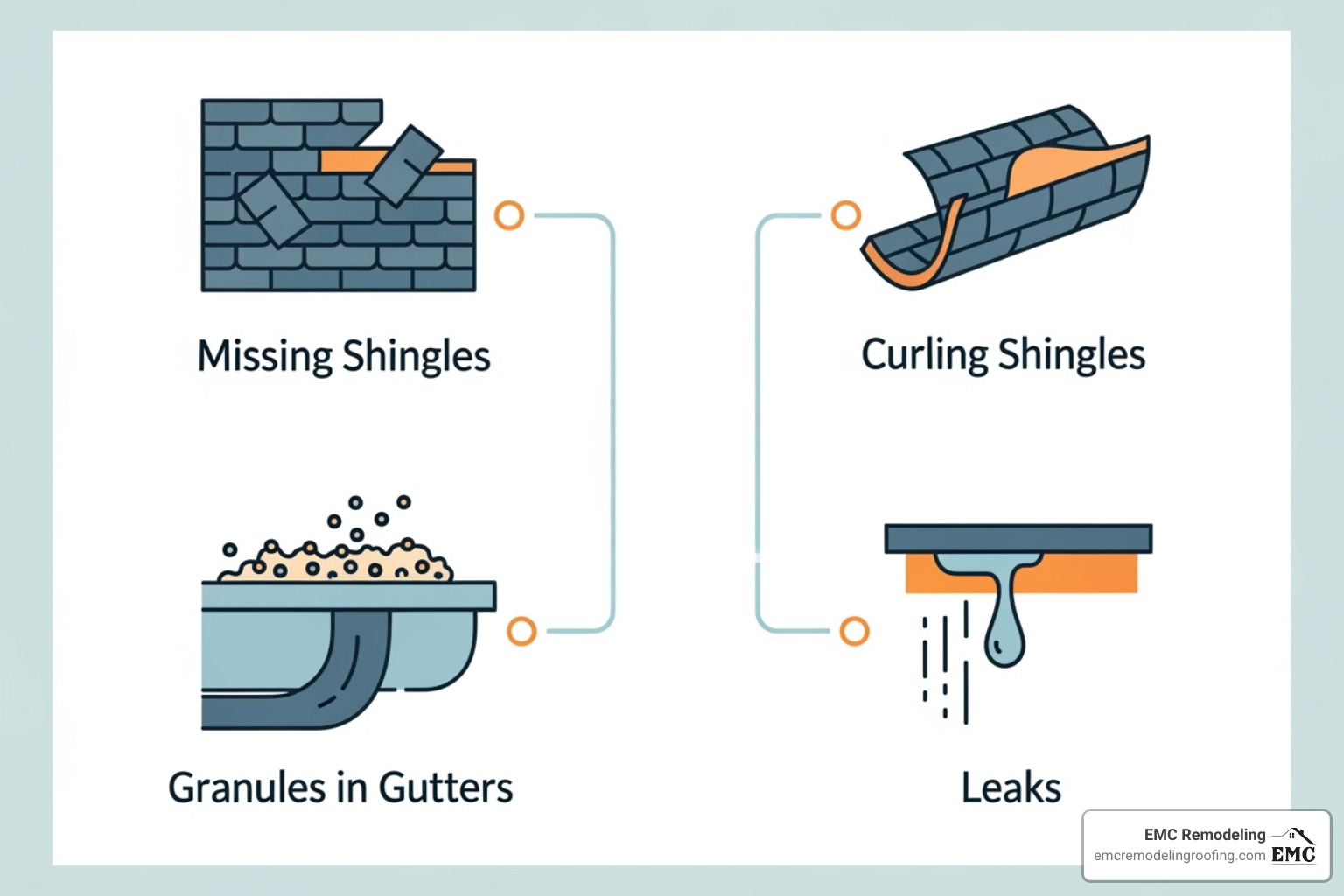Why Shingle Roof Replacement is Critical for Texas Homeowners
For Texas homeowners, a shingle roof replacement is a critical investment when your roof shows signs of aging, storm damage, or significant wear. Your roof shields your family from scorching summers and sudden hailstorms, but asphalt shingles typically only last 15-30 years. Understanding the process helps you decide between a DIY approach and hiring professional roofing services.
Key Steps for Shingle Roof Replacement:
- Assess Damage: Look for curling, missing, or cracked shingles.
- Plan: Gather tools, materials, and safety equipment.
- Remove Old Shingles: Strip the roof down to the deck.
- Install New Materials: Layer underlayment and new shingles.
- Finish: Add flashing, ridge caps, and clean up debris.
When to Replace vs. Repair:
- Replace if: The roof is over 20 years old, more than 20% of shingles are damaged, or multiple leaks are present.
- Repair if: Damage is less than 5%, leaks are isolated, or there’s minor storm damage.
As President of EMC Remodeling & Roofing, I’ve seen that knowing what’s involved in a shingle roof replacement makes all the difference in protecting your investment, whether you do it yourself or hire a professional.
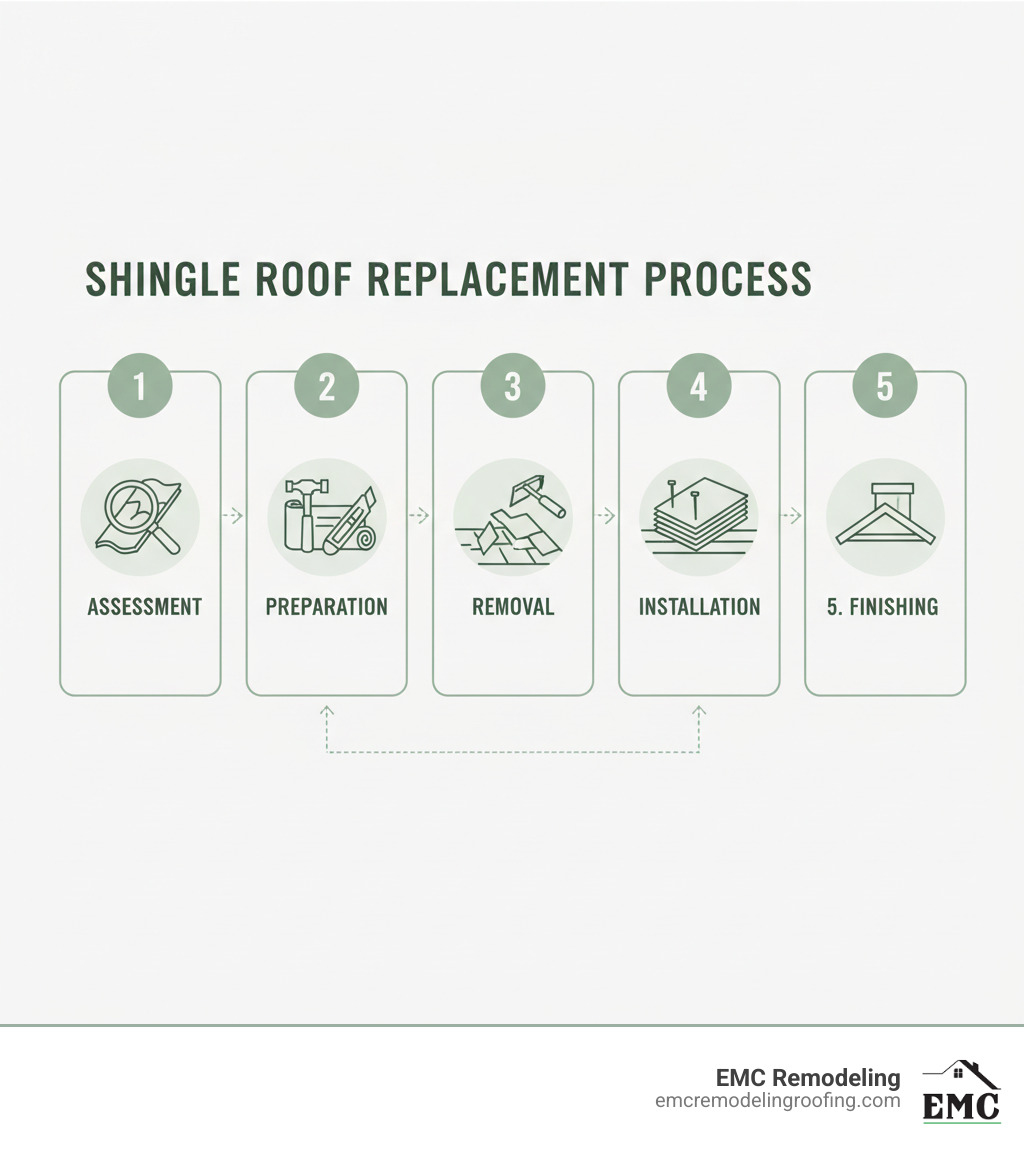
This guide will walk you through everything from spotting warning signs to understanding the difference between a simple roof repair and a full replacement.
7 Warning Signs You Need a Shingle Roof Replacement
Recognizing warning signs early can prevent expensive emergencies. A professional roof and attic inspection can confirm if your home needs a shingle roof replacement. Here are seven key indicators to watch for:
- Curling, Buckling, or Missing Shingles: Shingles that are curling at the edges, buckling in the middle, or missing entirely expose the underlayment to Texas weather, signaling the end of their lifespan.
- Cracked or Broken Shingles: Caused by heat, hail, or age, cracks compromise your roof’s ability to shed water and can lead to significant leaks if ignored.
- Excessive Granule Loss in Gutters: These sand-like particles protect shingles from UV rays. Finding large amounts in your gutters means the shingles are deteriorating and losing their protective layer.
- Roof Age Over 20 Years: Most asphalt shingle roofs last 15-30 years. If your roof is approaching this age, it’s wise to budget for a replacement, even if it looks fine from the ground.
- Leaks or Interior Water Stains: Brown spots on ceilings or walls are a clear sign that water is penetrating your roof. This can lead to mold, rot, and structural damage far more costly than a replacement.
- Moss or Algae Growth: In Texas’s humid climate, moss and algae trap moisture against shingles, accelerating their decay. Moss can also lift shingles, creating entry points for water.
- Sagging Roof Deck: A sagging roof is a serious structural safety issue, often caused by trapped moisture and rot in the underlying wood. This requires immediate professional attention.
Catching these signs early allows you to plan a replacement instead of reacting to an emergency.
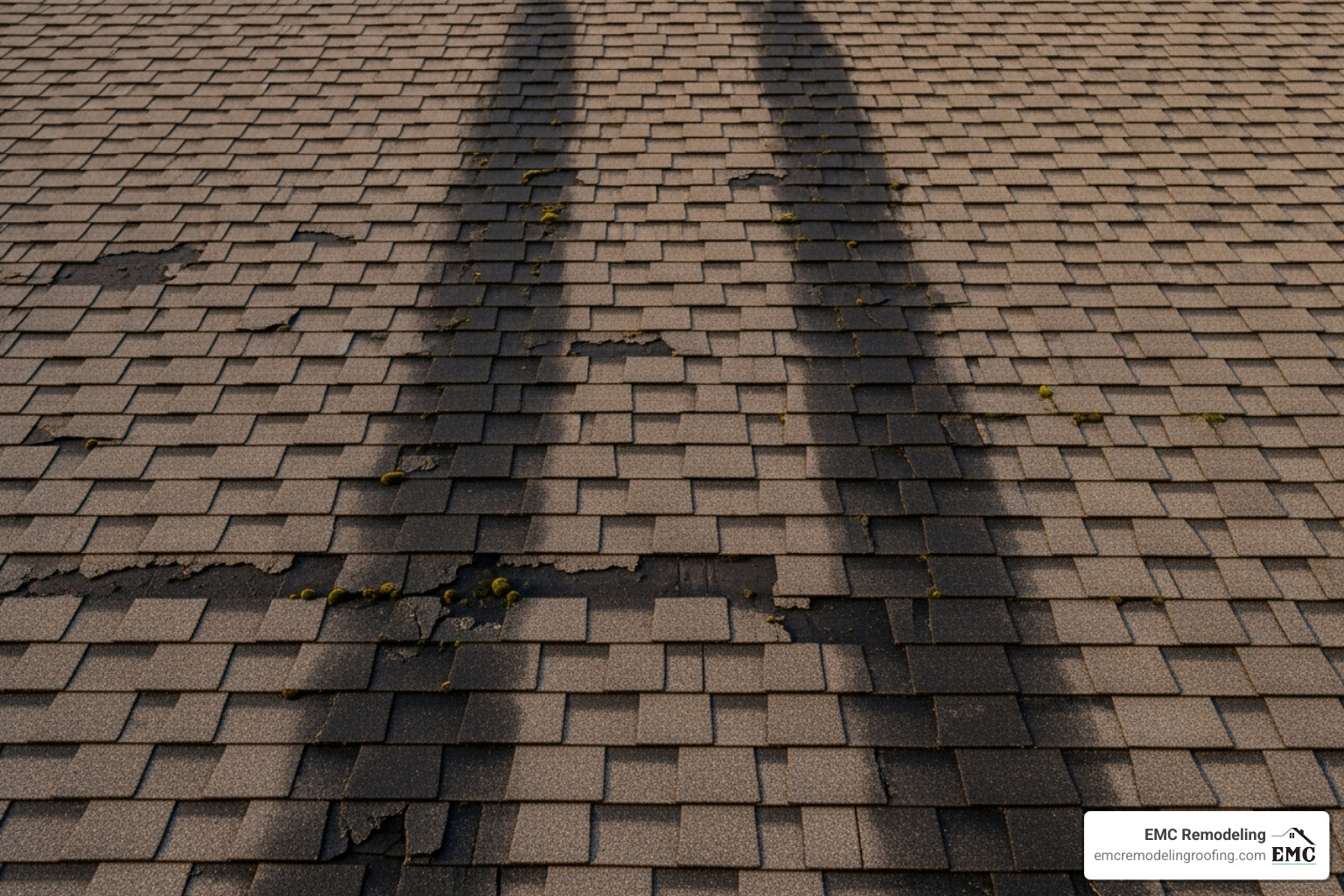
Gearing Up: Tools, Safety, and Shingle Selection
Proper preparation is essential for a successful shingle roof replacement. This means having the right tools, prioritizing safety, and selecting the best shingles for your home.
Must-Have Tools and Safety Gear
Roofing is a dangerous job involving heights and heavy materials. If you have any doubts about your ability to work safely, contact EMC Remodeling for professional help.
Essential Tool Kit:
- Pry Bar & Roofing Hammer: For removing old shingles and nails.
- Utility Knife & Tape Measure: For precise cutting and measurements.
- Chalk Line: To ensure straight shingle courses.
- Roofing Shovel: To speed up the tear-off process.
Critical Safety Gear:
- Sturdy Ladder & Safety Harness: Non-negotiable for fall protection.
- Slip-Resistant Boots: For traction on sloped surfaces.
- Work Gloves, Safety Glasses & Hard Hat: To protect from debris and sharp edges.
Always review OSHA’s residential roofing safety guidelines before you begin. For urgent issues, our emergency roof repair services are available 24/7.
Choosing the Right Asphalt Shingles
Your shingle choice impacts your home’s durability, curb appeal, and budget. In Central Texas, selecting a shingle that can withstand heat and hail is crucial.
- 3-Tab Shingles: A budget-friendly, flat option with a 15-20 year lifespan and wind resistance up to 110 mph.
- Architectural Shingles: A popular choice offering a dimensional look, a 25-30 year lifespan, and superior wind resistance (up to 130+ mph). They provide an excellent balance of cost and performance for Texas homes.
- Premium Designer Shingles: The luxury option, mimicking slate or wood shakes. They offer 30+ year warranties, the best wind and impact resistance, and a high-end aesthetic.
| Feature | 3-Tab Shingles | Architectural Shingles |
|---|---|---|
| Cost | $3–$5/sq. ft. (budget-friendly) | $5–$8/sq. ft. (moderate, good value) |
| Lifespan | 15–20 years | 25–30 years |
| Wind Resistance | Up to 110 mph | Up to 140 mph (high-end models) |
| Aesthetics | Flat, uniform, traditional | Textured, dimensional, varied |
Architectural shingles are often the best value, providing improved durability and curb appeal for the cost.
The Main Event: 5 Steps to a Successful Shingle Roof Replacement
A complete shingle roof replacement can be broken down into five manageable steps. Following them carefully ensures a durable, protective new roof for your home.
Step 1: Tear-Off and Debris Removal
Using a roofing shovel and pry bar, strip all old materials—shingles, underlayment, and flashing—down to the bare roof deck. Start at the ridge and work your way down, letting gravity assist. This is the messiest part of the job, so have a dumpster or disposal area ready.
Step 2: Deck Inspection and Repair
With the deck exposed, inspect it for moisture damage like soft spots, discoloration, or rot. Also, check for sagging surfaces or gaps. Any damaged plywood or OSB sheathing must be replaced to provide a solid foundation for the new roof. This step is critical for the long-term success of your roof.
Step 3: Installing Underlayment and Barriers
First, apply a self-adhering ice and water barrier along eaves, in valleys, and around penetrations like chimneys and vents for crucial waterproofing. Next, install roofing underlayment (synthetic or felt) horizontally from the bottom up, overlapping each layer. This acts as a secondary water barrier.
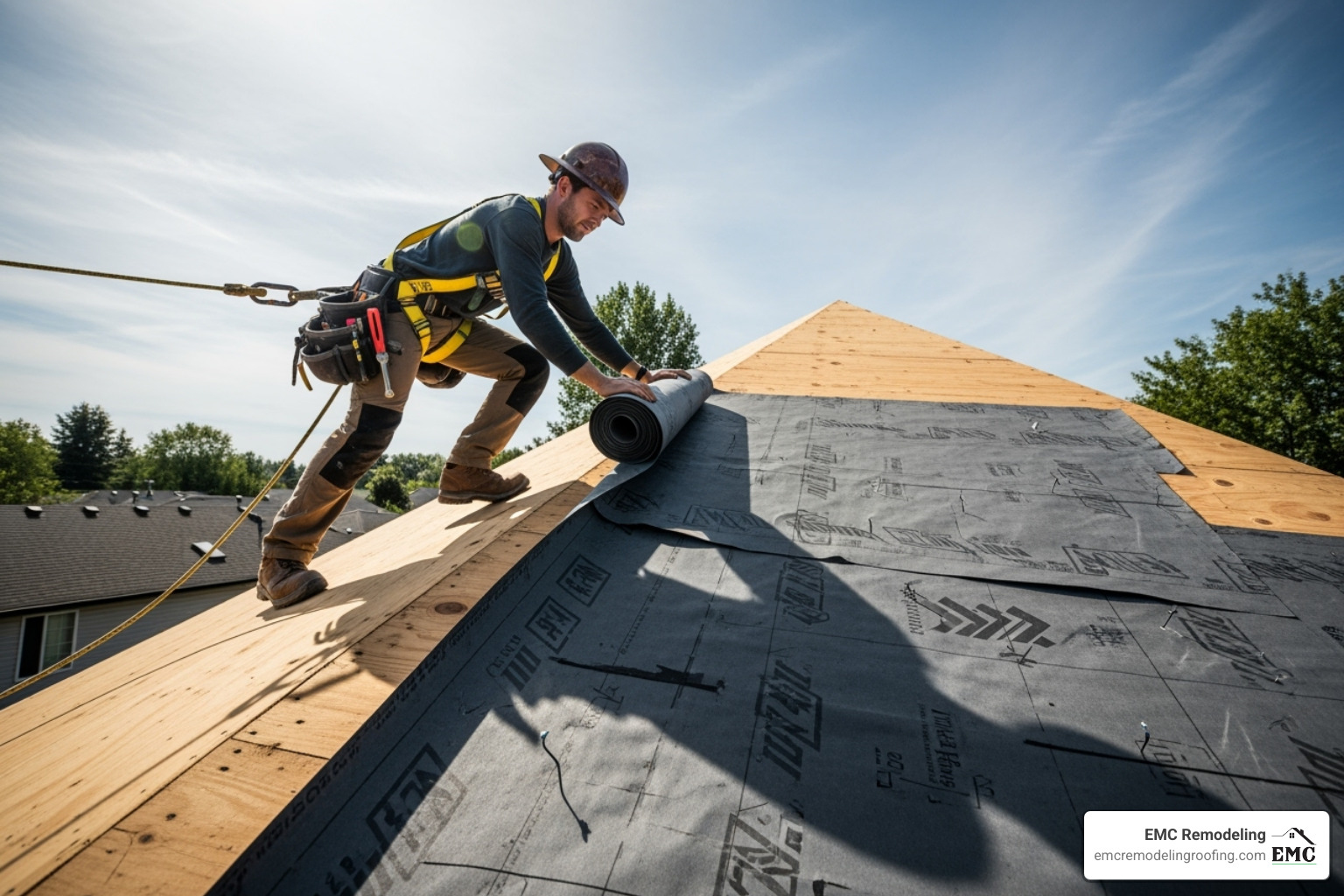
Step 4: Laying New Shingles
Begin by installing starter strips along the eaves to seal the edge and prevent wind uplift. Then, lay the field shingles from the bottom up, ensuring consistent overlap (exposure) and offsetting the joints on each row for proper water shedding. Proper nailing is crucial; follow the manufacturer’s specified nailing pattern exactly to prevent blow-offs and ensure warranty compliance.
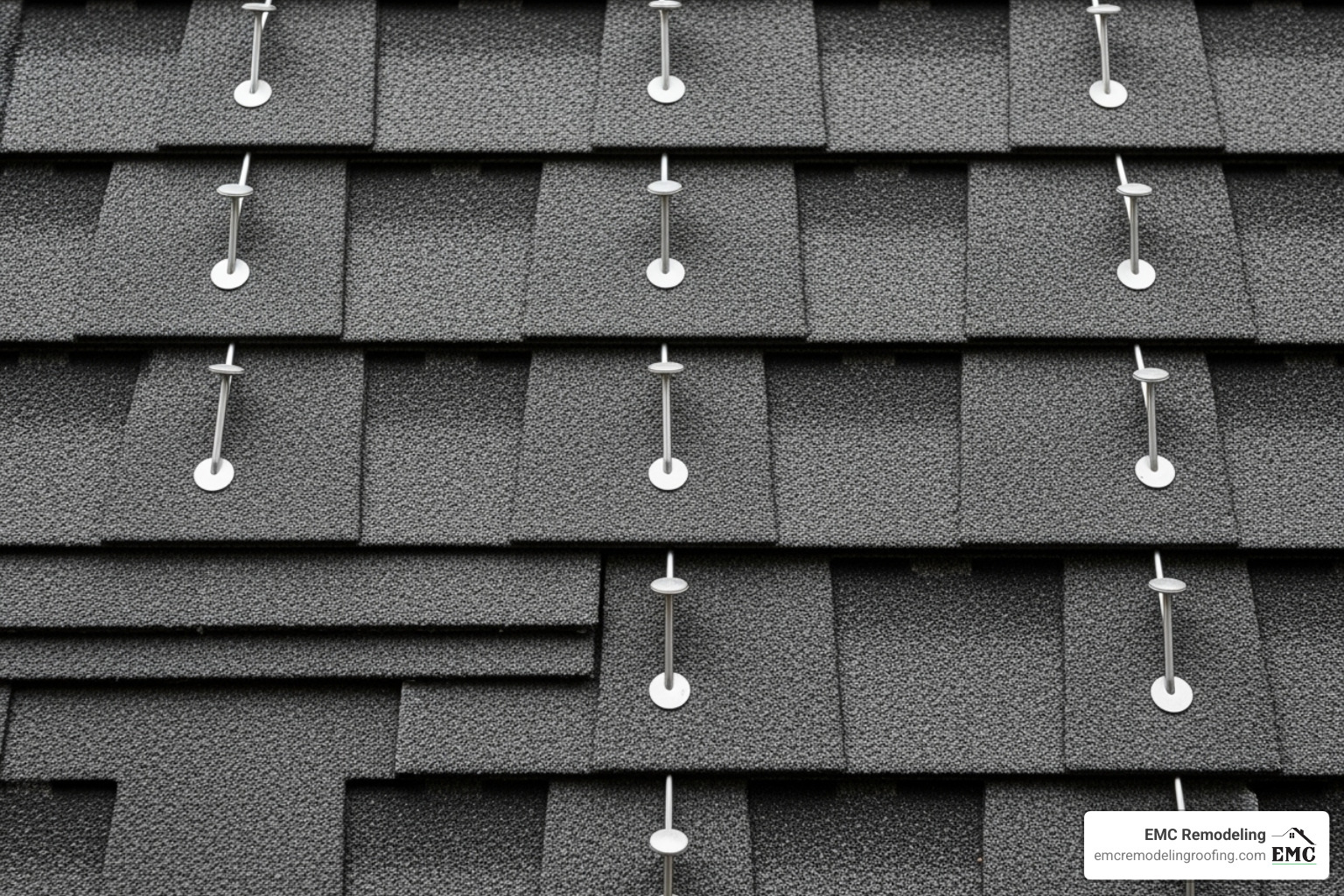
Step 5: Finishing Touches (Flashing, Vents, Ridges)
This final step ensures a watertight and professional finish. Install new flashing around chimneys, skylights, and vents to prevent leaks. Add ridge cap shingles over the roof’s peaks for a finished look and added protection. Ensure proper ventilation by installing ridge or soffit vents to prevent heat and moisture buildup. Finally, perform a thorough cleanup, using a magnetic sweeper to collect stray nails.
For more detailed guidance, see our Complete Roof Replacement Guide. If any step feels too complex, the team at EMC Remodeling is ready to help.
The Financials: What to Expect and How to Save
A shingle roof replacement is a significant but smart investment in your home’s protection and value. Understanding the costs involved helps you budget effectively.
Understanding the Cost of Shingle Roof Replacement
For a typical home, expect to invest $5,000 to $15,000 or more. This wide range is influenced by several factors:
- Roof Size and Pitch: Larger or steeper roofs require more materials and labor, increasing costs.
- Complexity: Features like dormers, skylights, and multiple valleys add to the installation time and cost.
- Shingle Choice: Architectural shingles cost more than 3-tab shingles but offer greater durability.
- Labor Costs: Rates vary by region and contractor experience.
- Additional Fees: Budget for permit fees ($150-$300), debris disposal ($200-$500), and potential decking repairs ($25-$50 per sheet).
For a personalized quote, see our guide on the price of a new roof.
Repair vs. Replacement: Making the Right Call
Knowing when to repair versus replace can save you thousands.
- When to Repair: Opt for roof repairs for isolated issues, such as less than 5% shingle damage or a single, contained leak. Timely repairs can extend your roof’s life by 5-15 years.
- When to Replace: A full replacement is necessary for widespread problems like damage to over 20% of shingles, multiple leaks, extensive granule loss, or a roof over 20 years old.
Storm and hail damage demands immediate action. Delaying can lead to severe issues. We offer storm damage repair, hail damage roof repair, and 24/7 emergency roofing services. If your home is damaged, we can also help you steer insurance roof claims to maximize your coverage.
DIY vs. Professional Roofing: When to Call the Experts
While a DIY shingle roof replacement can seem like a way to save money, roofing is dangerous, technical work where mistakes are costly. Knowing when to call a professional is key.
DIY Risks vs. Professional Benefits
DIY Risks:
- Safety: Falls from roofs are a leading cause of injury. Without proper safety equipment and training, the risk is significant.
- Improper Installation: Incorrect nailing, flashing, or underlayment installation can lead to leaks, blow-offs, and major water damage.
- Voided Warranties: Most shingle manufacturers require professional installation to validate their warranties.
- Time and Effort: A project that takes a professional crew 2-3 days could take a homeowner several weekends.
Professional Benefits:
- Expertise and Efficiency: An experienced roofing company has the knowledge to handle unexpected issues and complete the job correctly and quickly.
- Safety and Insurance: Professionals follow OSHA guidelines and are fully insured, protecting you from liability.
- Guaranteed Quality: Reputable contractors offer workmanship and material warranties, ensuring peace of mind.
- Insurance Claim Assistance: Pros can help steer insurance roof claims after storm damage.
Finding the Right Professional Partner
When hiring a contractor, verify they are licensed and insured. Look for manufacturer certifications, positive local reviews, and a physical address to avoid “storm chasers.” Ensure all project details—scope, materials, and warranties—are documented in a clear contract.
For reliable roofing services in Central Texas, our family-operated business is here to help. If you need a roofer near you, contact our team.
EMC Remodeling
Address: 5100 Midway Dr Suite 211, Temple, TX 76502
Phone: (254) 760-9268
Frequently Asked Questions about Shingle Roof Replacement
Here are answers to common questions about shingle roof replacement.
How long does a shingle roof replacement take?
Most residential projects are completed in 1 to 3 days. The timeline depends on your roof’s size and complexity, weather conditions, and whether any deck repairs are needed. A smaller, simple roof might take a day, while a larger, complex one could take longer.
Can I install new shingles over old ones?
A “roof-over” is not recommended. It adds excessive weight, can hide underlying deck damage, and prevents new shingles from lying flat, which compromises their performance and voids most manufacturer warranties. A full tear-off is the best practice for a long-lasting roof.
Can you replace shingles in any weather?
No, shingle roof replacement requires mild, dry weather. Asphalt shingles need temperatures above 40°F (5°C) to seal properly for wind resistance. Rain, ice, or high winds create unsafe working conditions and can compromise the installation. For urgent issues in bad weather, we provide emergency roof repair services to secure your home until a full replacement is possible.
Conclusion
Your roof is your home’s first line of defense against harsh Central Texas weather. A shingle roof replacement is a smart investment in your family’s safety, your property’s value, and your home’s curb appeal.
This guide has equipped you with the knowledge to identify warning signs, understand the replacement process, and weigh the pros and cons of a DIY project versus hiring professionals. This confidence allows you to spot problems early and make the best decision for your home.
When you’re ready for a professional, long-lasting solution, EMC Remodeling is your trusted local partner in Temple, TX, and the surrounding areas. We are committed to protecting your home and providing peace of mind with a high-quality roof replacement.
